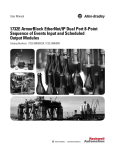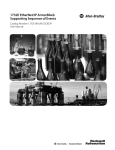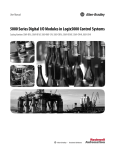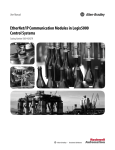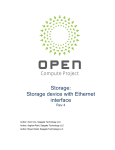Download ControlLogix Sequence of Events Input Modules Firmware Revision
Transcript
Release Notes ControlLogix Sequence of Events Input Modules, Firmware Revision 2.009 Catalog Numbers 1756-IB16ISOE, 1756-IH16ISOE Topic Page Enhancements 1 Corrected Anomalies 2 Firmware 2.007 and Enhancements 2 Per Point Module Operation 3 FIFO Mode Operation 4 Tag Definitions 7 x10 Retrieval Example 8 Download the Firmware 10 Additional Resources 10 IMPORTANT Firmware revisions now use three digits after the decimal point to indicate minor revisions, for example, revision 2.009 instead of revision 2.9. Software versions now use two sets of decimal points to denote minor and subminor versions, for example, version 21.00.00, not 21.00. Enhancements The ControlLogix® Sequence of Events module, firmware revision 2.007 and later has these enhancements. Table 1 - Enhancements with Revision 2.007 Cat. No. Enhancement 1756-IB16ISOE, 1756-IH16ISOE You can timestamp by using either CST values or CIP Sync values in the FIFO and Per Point modes of operation. In FIFO mode, you have the ability to retrieve 10 timestamps per RPI regardless of CST or CIP Sync timestamping choice. 2 ControlLogix Sequence of Events Input Modules, Firmware Revision 2.009 Corrected Anomalies The following anomalies have been corrected. Table 2 - Corrected Anomaly with Revision 2.009 Cat. No. Description 1756-IB16ISOE, 1756-IH16ISOE CORRECTED The CIP Sync functionality that was inadvertently disabled in version 2.008, resulting in timestamps using CST when CIP Sync timestamping was selected, has been re-enabled. Table 3 - Corrected Anomaly with Revision 2.008 Firmware 2.007 and Enhancements Cat. No. Description 1756-IB16ISOE, 1756-IH16ISOE CORRECTED If the RPI is set to 2 ms or less and you cycle power to the rack or remove and insert the controller while under power (RIUP), could cause the module to fault. The ControlLogix® Sequence of Events module, firmware revision 2.007 has these enhancements: • The ability to timestamp by using either CST values or CIP Sync values in the FIFO and Per Point modes of operation • The ability, in FIFO mode, to retrieve 10 timestamps per RPI regardless of CST or CIP Sync timestamping choice These features are enabled starting in RSLogix™ 5000 programming software, version 18.00.00, where new configuration profiles, defaulted at Major Revision 2, are provided for the 1756-IB16ISOE and 1756-IH16ISOE modules. These profiles let you choose what type of timestamp you prefer (CST or CIP Sync), and provide two new CIP Sync communication formats. These formats create additional ‘offset’ tags in the input structure that allow for correction (if necessary) of the module's accumulated timestamps. See the Integrated Architecture™ and CIP Sync Configuration Application Technique, publication IA-AT003, for details on how to use the offset tags. These acronyms appear in these release notes. Acronym Definition SOE Sequence of Events module CST Coordinated System Time CIP Sync A system-wide single time source RIUP Removal and insertion a module under power RPI Requested Packet Interval is a user configurable parameter that defines the maximum amount of time between the production of I/O data from the module Rockwell Automation Publication 1756-RN615E-EN-E - October 2012 ControlLogix Sequence of Events Input Modules, Firmware Revision 2.009 3 Per Point Module Operation Per Point mode module operation still provides a single On and Off timestamp for each input point on the module. However, with firmware revision 2.007, those timestamp values can be either in CST or CIP Sync format. Per Point operation begins with the selection of the appropriate communication format in RSLogix 5000 software, version 20.00.00 or earlier and Logix Designer application, version 21.00.00 or later. There are now two Per Point Comm Format selections: CIP Sync Per Point and CST Per Point. Choosing either Per Point Comm Format results in an input tag structure with a single On and Off timestamp value per input point, as well as some additional general-purpose CIP Sync status tags. However, choosing the CIP Sync Per Point option results in the creation of two additional input tags to assist in timestamp corrections in a CIP Sync architecture: I:LocalClockOffset and I:OffsetTimestamp. The Comm Format selection does not define whether the module timestamps by using CST or CIP Sync values. It only affects what tags are generated. Rockwell Automation Publication 1756-RN615E-EN-E - October 2012 4 ControlLogix Sequence of Events Input Modules, Firmware Revision 2.009 After you choose a Comm Format, a checkbox on the Configuration tab of the profile defines how the module will perform timestamping. When Timestamp in CIP Sync is checked, the module time stamps by using CIP Sync values. When Timestamp in CIP Sync is not checked, the module time stamps by using CST values. Desired Timestamp Communication Format CIP Sync Checkbox CST CST Per Point Not checked CIP Sync CIP Sync Per Point Checked For more information about Per Point mode, see the ControlLogix Sequence of Events Module User Manual, publication 1756-UM528. The Latch checkbox latches the CST or CIP Sync timestamps so that recorded events are not discarded until you acknowledge them. As a result, if latching is selected and new events occur, they will be ignored until the existing event is acknowledged. FIFO Mode Operation FIFO mode module functionality still provides these features: • An onboard buffer that holds 160 timestamps and stores the Timestamp, Event Number, Status, and Input Point number in the queue • Two Retrieval methods: Standard FIFO and ‘By Point’ However, with firmware revision 2.7, those timestamp values can be either in CST or CIP Sync format, and it is now possible to retrieve 10 timestamps per transfer versus the single timestamp per transfer. Rockwell Automation Publication 1756-RN615E-EN-E - October 2012 ControlLogix Sequence of Events Input Modules, Firmware Revision 2.009 5 FIFO mode operation begins with the selection of the appropriate communication format in RSLogix 5000 software, version 20.00.00 or earlier and Logix Designer application, version 21.00.00. There are now two FIFO mode Comm Format choices: CIP Sync 10x FIFO Mode and CST FIFO Mode. Choosing the CST FIFO Mode Comm Format results in an input tag structure that facilitates retrieval of a single timestamp event per RPI (as has always been done). However, choosing the CIP Sync 10x FIFO Mode option results in the creation of a 10 element array in the input tag area to facilitate the retrieval of 10 timestamp events per RPI (as shown below). Rockwell Automation Publication 1756-RN615E-EN-E - October 2012 6 ControlLogix Sequence of Events Input Modules, Firmware Revision 2.009 The CIP Sync 10x FIFO Mode option also results in the creation of two additional input tags to assist in timestamp corrections in a CIP Sync architecture: I:LocalClockOffset and I:OffsetTimestamp. The Comm Format selection does not define whether the module time stamps by using CST or CIP Sync values. It only affects what tags are generated. This means that you can use the x10 retrieval mechanism and still time stamp in CST. See below for details. After a Comm Format is selected, a checkbox on the Configuration tab of the profile defines how the module will perform timestamping. When Timestamp in CIP Sync is checked, for all Comm Formats, the module time stamps by using CIP Sync values. When Timestamp in CIP Sync is not checked, the module time stamps by using CST values. Use this table to determine which timestamping options to choose. Desired Timestamp Retrieval Method Communication Format CIP Sync Checkbox CST 1 item at a time CST FIFO Mode Not checked 10 items at a time CIP Sync 10x FIFO Mode Not checked 1 item at a time CST FIFO Mode Checked 10 items at a time CIP Sync 10x FIFO Mode Checked CIP Sync For more information about FIFO mode, see the ControlLogix Sequence of Events Module User Manual, publication 1756-UM528. Rockwell Automation Publication 1756-RN615E-EN-E - October 2012 ControlLogix Sequence of Events Input Modules, Firmware Revision 2.009 7 Tag Definitions When Timestamp in CIP Sync is checked, the following occurs: • For CIP Sync Comm Formats, the module time stamps with CIP Sync and provides I:LocalClockOffset and I:OffsetTimestamp tags. • For CST Comm Formats, the module time stamps with CIP Sync but does not provide I:LocalClockOffset and I:OffsetTimestamp tags. This may be a good option if you plan to use CIP Sync in the future. If you check this checkbox, you do not have to delete and then reconfigure the module when you decide to use CIP Sync technology. CIP Sync Tags All Comm Formats provide these CIP Sync tags. Tag Type Tag Description Config TimestampCIPSync(1) 1 = The module time stamps in CIP Sync. 0 = The module time stamps in CST. Input Returning CIPSyncTime 1 = Timestamps are returned in terms of CIP Sync. 0 = Timestamps are returned in terms of backplane CST. CIPSyncValid(2) 1 = CIP Sync is available on the backplane. 0 = CIP Sync is not available on the backplane. CIPSyncTimeout 1 = The module was connected to a valid local (in-chassis) time master that has timed out (no CIP Sync update over a 6 second period). The module is now using its own clock to time stamp (drifting at a rate of ~1 μs/s versus being synched). 0 = Either: • No local time master has ever been seen (CIPSyncValid = 0). • CIP Sync value is currently being received from Grandmaster (normal state if CIPSyncValid bit = 1). (1) Timestamp tags contain CIP Sync values when Timestamp in CIP Sync is checked. (2) For more information, see the Integrated Architecture and CIP Sync Configuration Application Technique, publication IA-AT003. CIP Sync Comm Formats provide these tags to monitor the offset between the Grandmaster and CST. Tag Type Tag Description Input LocalClockOffset 64-bit value that displays (in μs) the offset between current CST and CIP Sync value when a valid CIP Sync time is available (CIPSyncValid = 1). OffsetTimestamp(1) 64-bit CIP Sync value of when LocalClockOffset was last applied. Updates once per second when local time master is active and C.TimestampCIPSync = 1. (OffsetTimestamp = 0 if the module is not time stamping in CIP Sync). (1) Value in this tag should be recorded immediately following a large jump in time of the LocalClockOffset. Rockwell Automation Publication 1756-RN615E-EN-E - October 2012 8 ControlLogix Sequence of Events Input Modules, Firmware Revision 2.009 A Grandmaster device change or Grandmaster clock being Hand Set during the SOE event timestamp-recording process could cause an Event CIP Sync Time Source bump. After this bump, you need to add or subtract the timestamp offset value to the specific event timestamp. This verifies that the timestamp is accurate compared to other event timestamps that were recorded before the shift in Grandmaster time. This is a list of time stamped events from an SOE module. At 10:00:05.000000, a Grandmaster time change occurred at the fifth event recorded so the fifth and sixth event timestamps were recorded with old time. These event timestamps will need to be adjusted with the offset timestamp delta. SOE Event Number SOE Timestamps Collected (h:m:s.μs) SOE Offset Timestamp (h:m:s.μs) Offset Timestamp Delta (μs) Relative SOE Timestamp (h:m:s.μs) 1 10:00:00.100000 10:00:00.100000 0 10:00:00.100000 2 10:00:01.102000 10:00:01.102000 0 10:00:01.102000 3 10:00:02.300000 10:00:02.300000 0 10:00:02.300000 4 10:00:03.999000 10:00:03.999000 0 10:00:03.999000 5 10:00:05.000000 10:00:04.999980 -20 10:00:04.999980 6 10:00:05.001000 10:00:05.000980 -20 10:00:05.000980 x10 Retrieval Example The retrieval mechanism for x10 FIFO mode operation operates exactly as it has in the past, with the obvious exception of transferring 10 events instead of 1 per update. As mentioned, an array of 10 elements is now provided in the Input tag structure, and each element contains an Event Number tag as shown below. There is also a tag called EventsQueuedCount that indicates the number of events in the buffer. This number decreases each time a retrieval is performed. To retrieve events, perform these checks: • Copy and/or store array information. • Check the EventsQueuedCount tag and if > 10, copy Event[9]Number into O.Event_Ack tag to acknowledge receipt and queue the next 10 events. If EventsQueuedCount tag < 10, copy the last non-zero Event[x]Number into O.Event_Ack tag to acknowledge receipt. Rockwell Automation Publication 1756-RN615E-EN-E - October 2012 ControlLogix Sequence of Events Input Modules, Firmware Revision 2.009 9 In this example, the buffer has 23 events to retrieve. Before any acknowledgements occur, the module sends the information related to events 1…10 in the array every RPI, and the EventsQueuedCount tag = 23. Because the EventsQueuedCount tag >10, you can copy Event[9]Number (which has a value of 10) into the O.EventAck tag to acknowledge receipt and queue up the next 10 events. In the following update, the module sends the information related to events 11…20 in the array, and the EventsQueuedCount tag = 13. Because the EventsQueuedCount tag is still >10, you can copy Event[9]Number (which now has a value of 20) into O.EventAck tag to acknowledge receipt and queue the next 10 events. In the following transfer, the module sends the information related to events 21…30 in the array (though only 3 events are recorded), and the EventsQueuedCount tag = 3. Because the EventsQueuedCount tag is < 10, you can search for the last non-zero Event Number (which in this case is Event[2]Number), and copy its value (which is now 23) into O.EventAck tag to acknowledge receipt. This same mechanism can be used for Retrieval by Point if desired. For more information, see the ControlLogix Sequence of Events Module User Manual, publication 1756-UM528. Rockwell Automation Publication 1756-RN615E-EN-E - October 2012 10 ControlLogix Sequence of Events Input Modules, Firmware Revision 2.009 Download the Firmware To upgrade your SOE module firmware, download the firmware from the Rockwell Automation® Support Website at http://www.rockwellautomation.com/support/. Use ControlFLASH™ software to upgrade the module. IMPORTANT • All existing modules can be upgraded to revision 2.009. • For applications that require revision consistency, you can load revision 1.5 instead of revision 2.009. • We recommend that all SOE modules are upgraded to firmware revision 2.009 for consistency across your system. Additional Resources These documents contain additional information concerning related products from Rockwell Automation. Resource Description ControlLogix Sequence of Events Module User Manual, publication 1756-UM528 Provides information for configuring and using the SOE module. ControlLogix 24/48V DC (10-55V) Sequence of Events Module Installation Instructions, publication 1756-IN591 Provides instructions and wiring diagrams for the installation of the SOE module. ControlLogix Sequence of Events Module Installation Instructions, publication 1756-IN592 Provides instructions and wiring diagrams for the installation of the SOE module. Industrial Automation Wiring and Grounding Guidelines, publication 1770-4.1 Provides general guidelines for installing a Rockwell Automation industrial system. Product Certifications website, http://www.ab.com Provides declarations of conformity, certificates, and other certification details. You can view or download publications at http://www.rockwellautomation.com/literature/. To order paper copies of technical documentation, contact your local Allen-Bradley distributor or Rockwell Automation sales representative. Rockwell Automation Publication 1756-RN615E-EN-E - October 2012 ControlLogix Sequence of Events Input Modules, Firmware Revision 2.009 11 Notes: Rockwell Automation Publication 1756-RN615E-EN-E - October 2012 Rockwell Automation Support Rockwell Automation provides technical information on the Web to assist you in using its products. At http://www.rockwellautomation.com/support, you can find technical manuals, technical and application notes, sample code and links to software service packs, and a MySupport feature that you can customize to make the best use of these tools. You can also visit our Knowledgebase at http://www.rockwellautomation.com/knowledgebase for FAQs, technical information, support chat and forums, software updates, and to sign up for product notification updates. For an additional level of technical phone support for installation, configuration, and troubleshooting, we offer TechConnectSM support programs. For more information, contact your local distributor or Rockwell Automation representative, or visit http://www.rockwellautomation.com/support/. Installation Assistance If you experience a problem within the first 24 hours of installation, review the information that is contained in this manual. You can contact Customer Support for initial help in getting your product up and running. United States or Canada 1.440.646.3434 Outside United States or Canada Use the Worldwide Locator at http://www.rockwellautomation.com/support/americas/phone_en.html, or contact your local Rockwell Automation representative. New Product Satisfaction Return Rockwell Automation tests all of its products to ensure that they are fully operational when shipped from the manufacturing facility. However, if your product is not functioning and needs to be returned, follow these procedures. United States Contact your distributor. You must provide a Customer Support case number (call the phone number above to obtain one) to your distributor to complete the return process. Outside United States Please contact your local Rockwell Automation representative for the return procedure. Documentation Feedback Your comments will help us serve your documentation needs better. If you have any suggestions on how to improve this document, complete this form, publication RA-DU002, available at http://www.rockwellautomation.com/literature/. Allen-Bradley, Rockwell Software, Rockwell Automation, ControlLogix, RSLogix 5000, Integrated Architecture, TechConnect, and ControlFLASH are trademarks of Rockwell Automation, Inc. Trademarks not belonging to Rockwell Automation are property of their respective companies. Publication 1756-RN615E-EN-E - October 2012 Supersedes Publication 1756-RN615D-EN-E - March 2012 PN-176418 Copyright © 2012 Rockwell Automation, Inc. All rights reserved. Printed in the U.S.A.












